Why transcription is important for secondary market research. Carrying out market research is an essential part of any business. It’s by no means a straightforward task though. It’s often costly and to be successful, requires an understanding of what you want to achieve. One way to keep costs down and maintain focus is to use secondary research. Here we’ll discuss what secondary research means and the best ways you can make use of it.
What is secondary research?
Essentially secondary research means data that you do not collect directly by yourself. Primary research, on the other hand, is all research carried out by you, for example focus groups or surveys.
Making use of secondary research before embarking out on your own can be a good way to save time by finding out what information already exists in your area. This can include sifting through customer feedback and messages, all forms of government backed research including white papers and calls for information, and already published statistics on websites such as Statista. While some sources are free and accessible to all through a quick Google search, some may need to be paid for.
In short, secondary research can draw on the wealth of information that already exists, saving you time and money from having to do it all over again yourself. It also provides insight into competitors and market leaders, which can then inform business decisions.
Primary and secondary research
In the end, both primary and secondary research complement each other, because they both perform different tasks. Let’s be honest: primary research such as customer surveys are much more likely to return positive results if your brand is backed up by market data. By using secondary research to collect general data, you increase your chances of getting the specifics right and will be less likely to have to return to the drawing board.
Why transcripts unlock secondary research
Most of your secondary research sources will come in the form of information from other companies and organisations, for example recordings of customers or events. But extracting data from an audio file can be a challenge, plus you have the time consuming job of playing through the whole thing just to take out two or three points. This is where transcripts are a lifesaver, because they give you a full “birds eye” view of the whole recording and can be scanned through in minutes.
Transcripts are also useful for handling large volumes of consumer feedback. When conducting any form of market research quantity is an important factor in order to have a fair sample of your market. Having all this transcribed makes your life so much easier because it’s all there in front of you. With everything written out, you can quickly see what is and isn’t relevant, find common themes and then draw conclusions – an infinitely more difficult task if you have to listen to every comment over and over.
Final thoughts
Good quality market research is based on a number of different approaches, some of which will contain secondary research. Much of that secondary research will not be readily available in written form, but can be easily transcribed. So save yourself a wad of time and never miss a detail again by getting your secondary research transcribed with JUST.
Get started today with either AI Transcription or PodRecap – free trials available.


